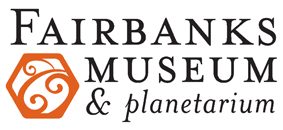
Climate Change
Statement on our changing global climate.
The Fairbanks Museum & Planetarium recognizes that climate change is real and is demonstrably linked to human activities.
Earth’s climate has changed often in the past, sometimes dramatically, resulting in ice ages and the intervals between them. However, recent changes in global climate have been far more rapid, outpacing the ability of many species to adapt. These changes are quantifiably linked to human activities.
Evidence of climate change is abundantly clear in numerous observable biological and physical changes including, but not limited to, rising sea levels, melting polar ice caps, melting glaciers, and changing ocean chemistry. Climate change is and will have a dramatic impact on mass transnational human migration.
The Fairbanks Museum concurs with the American Meteorological Society’s 2019 statement on climate change:
Research has found a human influence on the climate of the past several decades. Its manifestation includes the warming of the atmosphere and oceans, intensification of the heaviest precipitation over continental areas, increasing upper-ocean acidity, increasing frequency and intensity of daily temperature extremes, reductions in Northern Hemisphere snow and ice, and rising global sea level. The latitudinal and seasonal observations of the surface warming and the observed warming of the troposphere and cooling of the stratosphere are consistent with theoretical expectations from increased concentrations of greenhouse gases.
The increase in global average surface temperature over the past half-century cannot be fully explained by natural climate variability, e.g., responses to Earth’s orbital changes over thousands of years, or natural climate forcing such as from solar or volcanic variability. The observed warming rate varies from place to place and from decade to decade because of natural climate variations, such as natural swings between El Niño and La Niña on time scales of two to seven years, and variations in ocean circulation in the Pacific and Atlantic basins on decadal to multi-decadal timescales. The influence of these relatively short-period fluctuations is factored into climate change analyses. These natural fluctuations have neither the magnitude nor the spatial characteristics to explain the observed warming of Earth’s average surface temperature over the past several decades. The IPCC (2013), USGCRP (2017), and USGCRP (2018) indicate that it is extremely likely that human influence has been the dominant cause of the observed warming since the mid-twentieth century.
Proxies, which are indirect measurements of past temperature obtained from archives, such as tree rings, corals, ice cores, lake and marine sediments, and cave stalagmites, reveal that the rate and magnitude of the current global temperature change is likely exceptional in the context of the last two thousand years. Global temperatures were last on par with the present ones in the previous Interglacial Period (125,000 years ago), when sea level was 6–9 m (20–30 ft) higher than today. Projected warming over the next century will likely place global temperatures in a range not seen in millions of years of geologic history.
Read the AMS’s full statement on climate change.
Climate change is the defining challenge of our times, and here’s what the Fairbanks Museum is doing to address the issue:
- Lead by Example. As an institution with four buildings, none of which are fewer than 100 years old, we’re demonstrating how to lessen our carbon impact. Since 2015, we’ve installed 112kW of grid-tied solar production, repowered two buildings with cold-climate heat pumps, installed grid-tied back-up batteries in all buildings, placed two EV charging stations into operation, and undertaken numerous energy efficiency projects.
- Teach the Science. Our public and educational program emphasize the seriousness of climate change and help the public to think about how to adapt while also promoting aggressive mitigation efforts to minimize the extent of future climate change. These programs take the form of public events and exhibits for our more than 30,000 annual visitors, classes we teach to more than 11,000 students from Kindergarten-12th grade each year, and inquiry-based work in our STEM Lab using computer models and laboratory research processes. We have also adopted educational materials developed as part of the NASA funded project “Real World, Real Science” (led by the Gulf of Maine Research Institute) and Northern Vermont University’s Climate Consensus Group.
- Record and Interpret the Data. The Fairbanks Museum maintains the second longest continuous weather record in the United States. We continue to keep current records, and use this data to show what our information reveals about climate change. Data from the museum’s historical record also has been put to use training the next generation of scientists in partnership with Northern Vermont University’s Atmospheric Sciences Department.
- Institutional Strategy. Climate change was included in our 2019-2021 Strategic Plan. As one of our seven purposes, the Fairbanks Museum is charged to “convey through exhibits, programs and facility projects the challenges of climate change, and the role we can play in mitigating its causes and effects.”
Adopted by the Board of Trustees, February 2020
